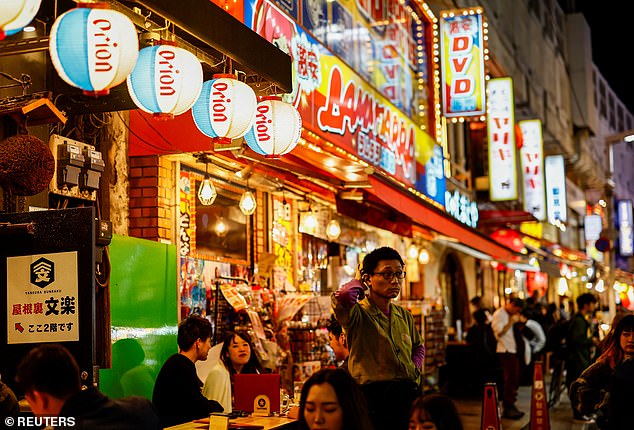If it’s any consolation, Britain is not alone in the doldrums.
The economic climate from East to West is equally stormy, with Japan in recession and China fighting to stimulate demand and stabilise its stock market as the pace of growth in the world’s industrial powerhouse peters out.
Across the continent, the prognosis is also poor. The European Commission slashed its previous growth predictions for the eurozone this year, forecasting that gross domestic product in all 20 countries will rise only 0.8 per cent rather than the 1.2 per cent forecast last November.
Next year is marginally better, at 1.5 per cent. By far the biggest drag on growth will be Germany, which has already been in and out of recession because of a collapse in manufacturing and higher energy costs.
Now, the EC has cut its earlier forecast to 0.3 per cent this year compared to 0.8 per cent.

Slump: A line of bars and restaurants in a busy Tokyo shopping district. Japan has lost its spot as the world’s third-biggest economy to Germany
Of the world’s major economies, only the US appears to be defying the misery. While growth is slowing, it is proving remarkably resilient despite the recent spike in inflation, and looks set to grow over 2 per cent.
Perhaps the most surprising news, though, is that Japan has lost its spot as the world’s third-biggest economy to Germany, as the Asian giant has slipped into recession.
Japan’s GDP is now $4.2trillion (£3.33trillion) compared to Germany’s $4.5trillion (£3.37trillion). Once the second-biggest economy on the planet, Japan has had two consecutive quarters of contraction.
Its problems are threefold: a weaker yen, declining population and high energy costs. The yen has fallen by a fifth over the last two years against the dollar.
This matters hugely as the low dollar rate hurts profits on exports – on which it is heavily dependent – when they are repatriated back home.
Japan, like neighbouring China, is sitting on a demographic timebomb because of an ageing population and low birthrate, which is leading to labour shortages.
Incontinence pads now outsell babies’ nappies as the population has shrunk from 128m in 2008 to 122m today, and continues to fall.
But Japan’s problem is stickier than other countries because its fertility rate fell below the replacement level in the early 1970s – well before elsewhere.
So it has much catching up to do. Last year, births fell below 800,000, the biggest fall since records began in the 1890s.
Governments have launched incentives, from longer parental leave to doubling maternity pay, to improve child-rearing.
They appear to have worked for a while, with the number of women in the workplace up to 82 per cent which, counterintuitively, saw a rise in the birthrate as working women have more children than those who do not.
But not by enough. Immigration has been shooting up as key industries have had to bring in labour or face ruin.
The non-Japanese population has swollen to 3.2m, an astonishing turnabout from its notorious ‘closed door’ reputation.
The Land of the Samurai has become the land of the baby bust.
There is much for other countries to learn from Japan’s experience.
Nvidia pays out the chips
Nvidia is on fire. The US chipmaker has overtaken Alphabet and Amazon to become the US’s third most valuable company after Microsoft and Apple, with a market cap of $1.8trillion (£1.4trillion).
It has also gone on a buying spree, snapping up stakes in five AI firms, taking it even deeper into data chips and the use of AI in healthcare to speed up drug discovery.
Its biggest investment was in Arm Holdings, the rival chip designer which Nvidia tried to buy for £32billion two years ago, a deal that crumbled after antitrust hurdles.
Shares in Arm shot up again on the news – they are 100 per cent higher than when they were listed – so you can see why it chose to list in New York rather than in London.
Nvidia has also invested in healthcare companies Nano-X Imaging, Recursion Pharmaceuticals and voice AI platform Sound Hound.
Last year, it snapped up 35 AI companies: Nvidia may be a trillion or so dollars in value behind the Big Tech boys but, at this rate, it won’t be long before it catches up.
Making up
Only 5 per cent of racing drivers are female but more than 40 per cent of F1 fans are women.
Feisty make-up queen Charlotte Tilbury is aiming to close the gap by sponsoring Formula 1’s F1 Academy project which is trying to bring more women into the sport.
Now that’s proper female power: Tilbury’s Scent of a Dream fragrance competing with the burnt rubber smells of the pit stop.
Some links in this article may be affiliate links. If you click on them we may earn a small commission. That helps us fund This Is Money, and keep it free to use. We do not write articles to promote products. We do not allow any commercial relationship to affect our editorial independence.



